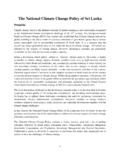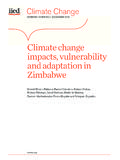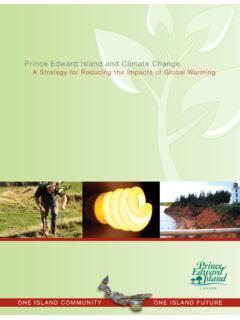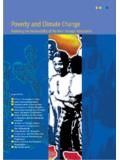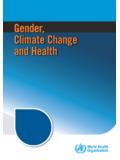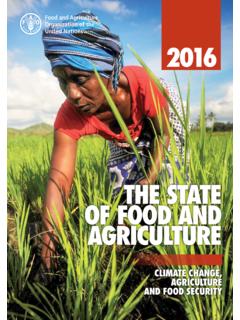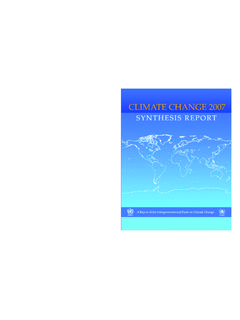Transcription of Climate Change and Agriculture: Economic Impacts
1 The magazine of food, farm, and resource issuesA publication of theAmerican AgriculturalEconomics Association 1999 2008 CHOICES. All rights reserved. Articles may be reproduced or electronically distributed as long as attribution to Choices and the AmericanAgricultural Economics Association is maintained. Choices subscriptions are free and can be obtained through 1st Quarter 2008 23(1) CHOICES 9 Climate Change and agriculture : Economic ImpactsJohn M. AntleJEL Classifications: Q1,Q2,Q3,Q4 agriculture is arguably the most important sector of the economy that is highly dependent on Climate . A large body of scientific data and models have been developed to predict the Impacts of the contemporary and future Climate . Since the first IPCC Assessment Report was published in 1990, substantial efforts have been directed toward understand-ing Climate Change Impacts on agricultural systems.
2 The resulting advances in our understanding of Climate Impacts have come from the collection of better data, the develop-ment of new methods and models, and the observation of actual changes in Climate and its Impacts . Such knowledge is critical as we contemplate the design of technologies and policies to mitigate Climate Change and facilitate adapta-tion to the changes that now appear inevitable in the next several decades and beyond. This article briefly summarizes some of the key findings from the research on agricultural Impacts of Climate Change , based on the recent IPCC Assessment Reports published in 2001 and 2007, and other recent work such as the recent assessment published in 2002 and the Council for Science and Technology report in 2004. In the remainder of this article, I discuss the substantial uncertainties that re-main about actual and potential Impacts of Climate Change on agriculture and its Economic consequences.
3 The paper concludes with some observations about linkages from im-pacts to Current State of KnowledgeEarly research on agricultural Impacts led to some rather dire predictions of adverse Impacts of Climate Change on food production, and the public perception that Climate Change may lead to global food shortages continues today. Although state-of-the-art at the time, the early predictions involved relatively simple data and methods, typically esti-mating the effects of increases in average annual tempera-ture on yields of a limited number of crops at a limited number of locations, and extrapolating the typically nega-tive effects to large regions. With advances in data and models, most assessments of the Impacts of Climate Change on agriculture predict that the world s ability to feed itself is not threatened by Climate Change .
4 The most recent IPCC report on Impacts and Adaptation finds that Climate Change is likely to have both positive and negative Impacts on agriculture , depend-ing on the region and the type of agriculture . Overall, the report predicts that during the present century there will be a marginal increase in the number of people at risk of hunger due to Climate Change . (Easterling et al. 2007, p. 275). However, research also shows that this finding should not lead to complacency, as analysis also suggests that some of the poorest and most vulnerable regions of the world are likely to be impacted negatively, and in some cases, se-verely. One of the most important advances made in response to these early studies was to recognize that Economic agents in this case, farmers and the various private and public institutions that support agriculture would adapt to cli-mate changes in ways that would tend to mitigate negative Impacts and take advantage of positive Impacts .
5 Another important advance in research was to recognize that there would be substantially different local, regional and global Impacts . As data and modeling capability has improved, it has become increasingly clear that there are likely to be substantial adverse changes in some particularly vulner-able regions, such as in the semi-arid tropics, but there is also likely to be positive changes in the highland tropics and in temperate regions (Parry et al 2004). As a result, the adverse effects in some regions are likely to be reduced through international trade with other regions that have been positively impacted. Collectively the regional and global Impacts are not likely to be large, and may even prove to be CHOICES 1st Quarter 2008 23(1) Impacts at the farm level include changes in crop and livestock pro-ductivity, which in turn will lead to changes in the most profitable pro-duction systems at a given location.
6 Research suggests that in highly pro-ductive regions, such as the Corn Belt, the most profitable production system may not Change much, but in transitional areas such as the eco-tone between the Corn Belt and the Wheat Belt, substantial shifts in crop and livestock mix, in productivity, and in profitability may occur. Such changes may be positive, for example if higher temperatures in the north-ern Great Plains were to be associated with increased precipitation, so that corn and soybeans could replace the wheat and pasture that presently pre-dominate. Such changes also could be negative, , if already marginal crop and pastureland in the south-ern Great Plains became warmer and drier. In addition to changes in tem-perature and precipitation, another key factor in agricultural productivity is the effect of elevated levels of atmo-spheric CO2 on crop yields.
7 Some estimates suggest that higher CO2 levels could increase crop productiv-ity substantially, by 50% or more, although these effects are likely to be constrained by other factors such as water and soil nutrients, particularly in the developing countries. In the case of the United States agriculture , aggregate Economic im-pacts of Climate Change are not ex-pected to be large, although there will be important regional differences. Re-cent studies estimate that crop yield changes will tend to be positive, with some almost doubling, but most in-creasing in the range of 10% to 40% during this century. Regionally, the northeast, south and southwest ben-efit the least, and the upper Midwest and coastal Northwest benefit the most. In contrast, livestock produc-tion is expected to be reduced by 5-7% due to higher average tempera-tures.
8 Economic Impacts associated with agriculture in the United States appear to be positive overall, with es-timates ranging from an annual loss of $ billion to a gain of about $5 billion, depending on the Climate sce-nario used, with consumers generally gaining from the increased produc-tivity and producers generally losing. The regional distribution of producer losses tends to mirror the productiv-ity Impacts , with the Corn Belt, the Northeast and south and southwest having the largest losses (McCarl 2008).The most vulnerable regions of the world are undoubtedly in the tropics, particularly the semi-arid regions where higher temperatures and reduction in rainfall and increas-es in rainfall variability could have substantially negative Impacts , and in coastal areas that are likely to be flooded due to sea level rise.
9 These Impacts are likely to be most severe in isolated regions where transportation costs are high, incomes are extremely low, and most rural households are highly dependent on agriculture for their livelihoods and for their food. These adverse Impacts are predicted to be most severe in parts of sub-Sa-haran Africa, and other isolated areas in southwestern and south Asia. Low-lying areas in south Asia, Indonesia, and other poor coastal regions are also likely to be severely impacted due to their vulnerability to sea level rise and a limited ability to adapt by moving to higher ground or making invest-ments to protect vulnerable areas. As a result, the risk of malnutrition and hunger in the developing world, par-ticularly in the highly vulnerable re-gions, is predicted to increase during this century (Parry et al.)
10 2004). UncertaintiesDespite the substantial advances in understanding of Climate Change and its agricultural Impacts , many uncertainties remain. Of particular concern are some of the limitations of the general circulation models used to simulate Climate changes, and the way those limitations may affect the predicted Impacts of Climate Change on agriculture . Some of these limita-tions suggest that the generally opti-mistic predictions outlined above for the temperate regions of the world, may be too sanguine. On the supply side, a critical limitation of GCMs is their ability to predict changes in Climate with the spatial resolution needed to model Impacts on agricultural productivity. As discussed in the companion ar-ticle in this issue by Adams and Peck, changes in water availability are espe-cially difficult to predict, particularly on the site-specific basis needed to quantify agricultural yield Impacts .





